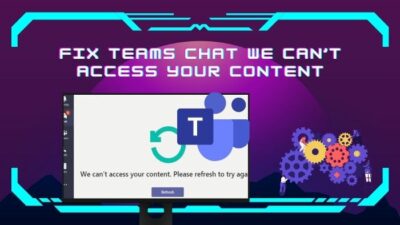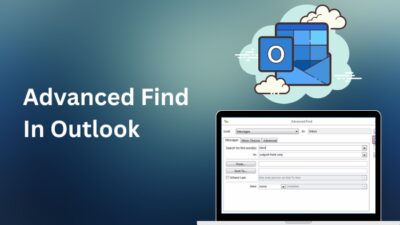A resume serves as one of the most, if not the most important, factors for getting a call for an interview from employers. Of course, the content on a resume is important, but how it is presented is also crucial.
It is not only about what is written but how it is written. You can have years of experience and have all the skills and qualifications. But if your resume looks bad, there’s a very low chance you will impress your employer.
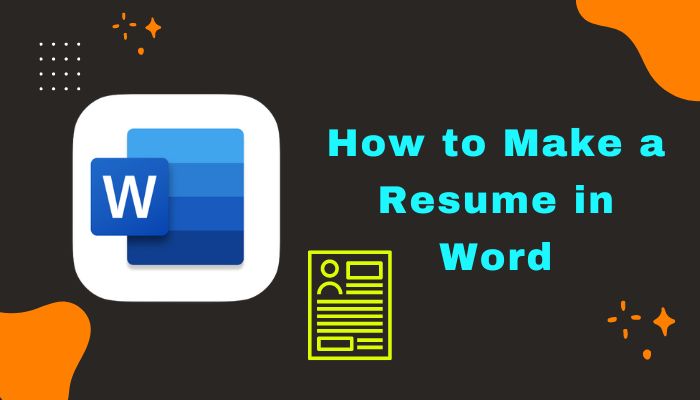
If you use a template, you don’t have to worry about this critical factor in designing your resume. It is already designed by professionals.
You just have to think about what to write and how to polish your resume to make it more unique.
How to Make a Professional Resume in Microsoft Word Using Templates?
In Microsoft Word, you can either make your resume from scratch or use the premade templates designed by professionals without worrying about font sizes, colors or structures.
Yes, using templates has a learning curve. But when you are all done with this article, it will be a piece of cake. You might be hesitant to use a template. You might be thinking, do other people use templates.
Don’t think about what other people do or don’t do. If it looks good, go for it.
These are the steps to create a resume from templates:
- Open Microsoft Word document.
- Click New from File.
- Go to Resumes and Cover Letters.
- Select the resume according to the job you are applying to.
- Click Create.
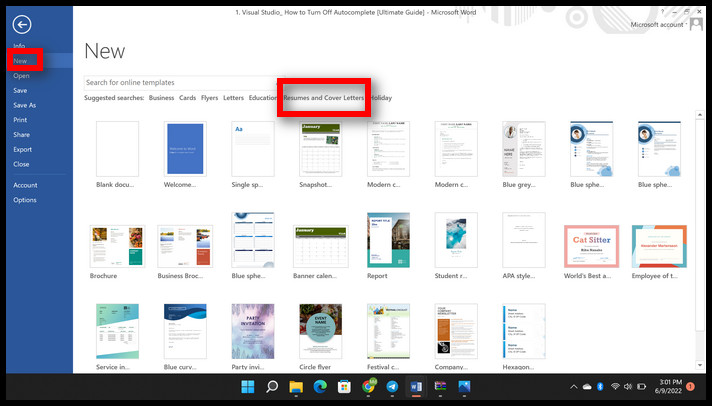
A new Word document of the template should open.
Here’s a complete guide on how to set background image on MS Word.
Complete Your Resume Template
Now that you’ve opened your resume template, it’s time to fill it with the correct information, as your name is not Name Here. You can also add more elements to the template.
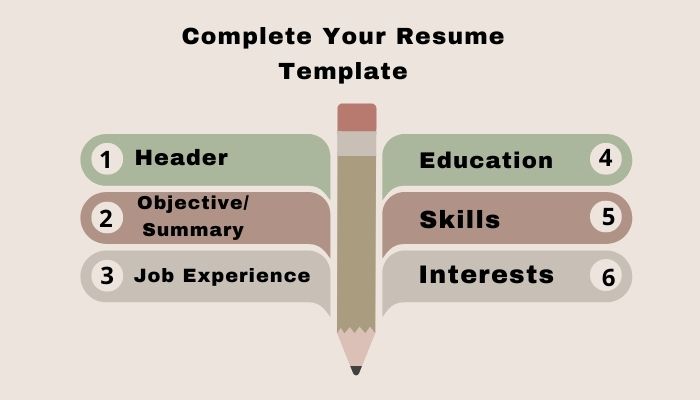
Here are some elements that you should include in your resume:
1.Header
This section includes your name, current job title (assuming you have one), phone number, email, and LinkedIn profile link.
Don’t change the font size provided by the template. Bold the titles of the information you are providing.
2.Objective/Summary
In this section, provide your job experience relevant to the job you are applying for in 2 or 3 sentences. Give sufficient space between the last line of the title and objective sections.
Also, check out our separate post on how to make only one page landscape in Word.
3.Job Experience
Provide your work history from the last job you had to the first, i.e., reverse chronologically. Just put the job title and what your responsibility was. Don’t add anything else.
In case you don’t have much job experience or are a fresher, you should use the functional type Basic design resume templates. I have described this in the later sections.
4.Education
List the degrees you’ve received in any order (chronologically or reverse-chronologically) you prefer. Also, add the school name, location, and the year you’ve obtained your degree.
5.Skills
Just make a list of the skills you have relevant to the job you are applying for. Use bullet points to make the list.
6.Interests
This section is optional. You can add your hobbies, personal interests, and volunteer work if you want.
Check out the easiest way to enable equation editor in Microsoft Word.
Tips to Make Your Resume Look More Professional
Your resume should be simple, concise, and easy to read. Should not have any info unnecessary to the job. Also, don’t add skills that are irreverent to the job you are applying for. Keep it clean. 1 line
Follow the given tips when filling the resume template:
1.Resume Should be Simple
In case you are a fresher or applying for an internship, choose a simple and easy template to edit. Don’t change the font size of the templates.
2.Resume Should be Concise
A busy hiring team usually skims through the resume. So, remove out-of-date and irreverent information. Keep your resume simple and clean.
3.Resume Should be Unique
Check and make sure that you have changed all the pre-provided information in the template.
Quickly check out our epic guide on how to enable word wrap in notepad.
4.Resume Name Should be Unique
Don’t give your resume a name like resume.doc. It will get lost in the sea of resumes. Rename it to your name like “your name.doc” or “your name.pdf” so the employer may know that it’s from you.
5.Resume File Format
It should be doc, docx or pdf. Suppose that an employer asks for a specific format, make sure to submit the correct one.
6.Proofread
Check that there are no spelling or grammatical errors before submitting your resume.
7.Resume Assistant for Microsoft Office 365
Office 365 users can use LinkedIn data to see other resume examples, get assistance from professionals and connect with employers. Resume assistant creates a new based on LinkedIn profiles as examples.
Check out this Resume Assistant and LinkedIn great resumes to know more.
Types of Templates in Microsoft Word
Now we move on to what type of template and what kind of design is good for what type of job.
As there are many free templates available, it can be a little overwhelming to choose the right format. But most of the jobs can be categorized into 3 types.
Here are the types of templates in Microsoft Word:
1.Chronological
In this type, you arrange your work experience, starting from the most recent to the very first one, i.e., reverse-chronologically. Then comes your education, skill and interests.
The chronological templates in Microsoft Word are simple, clean, easy to skim and professional-looking. Usually, this template type is good for applying in traditional companies like educational institutions, government agencies and businesses.
Choose this format assuming you can showcase other jobs that you already have experience with. Freshers should not use this type of template.
2.Functional Resume
This format is ideal for freshers and people with multiple gaps in their work history. In this type, skills and achievements are given more importance by putting them at the top of the resume.
Therefore, employers can decide to choose you or not based on your skill and achievements rather than your job history.
3.Combination
Use this format if you can show off your skill and achievements, as well as a pleasant work history. Give your work history and achievements in whichever order you like.
Have some time to spare? Quickly check out our epic guide on why can’t I copy paste in Microsoft Word.
Designs of Resume Templates
Don’t use the same template for all types of jobs. For entry-level jobs, the template should be simple and clean, for creative and designing jobs, the template should have more colors and different fonts.
It’s time to choose the right design according to the job you are looking for. 1-2 lines
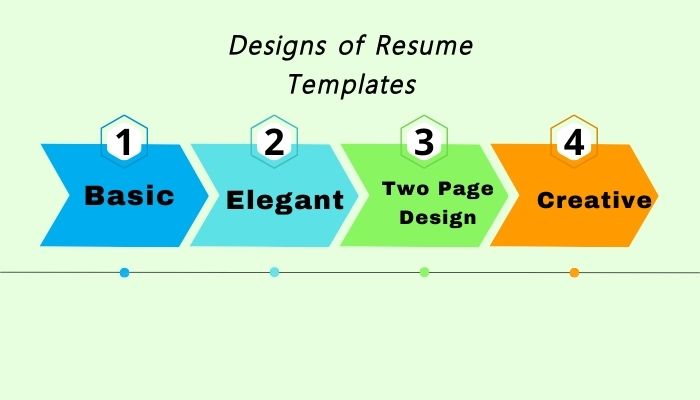
Here are some of the resume templates designs:
1.Basic
This is a good design in case you don’t have a lot of work experience or if you are a fresher applying for an internship or an entry-level job.
It is simple, clean, easy to read, and clearly states your details. If you are making a resume for the first time, use this design.
2.Elegant
Choose this design if you have multiple job experiences. Though it has more colors and qualities than basic design, the templates are not cluttering.
3.Two Page Design
You should always consider a single-page resume. However, in case you have a lengthy work history or are applying for an upper-level job such as director or Vice Chancellor, use this type of template.
Prioritize on making the resume clean.
4.Creative
This design has multiple colors, different fonts and decorations. But the templates in Microsoft Word don’t use these features to the extent that they look unprofessional. They are still clean and easy to read.
You should use this design if you apply for creative jobs like graphic designer, photographer and web developer.
FAQs
Does Microsoft Word have built-in resume templates?
Yes, Microsoft Word has a wide range of free templates for you to choose from. Check here, Microsoft Word Resume Templates.
How do you download a free resume template on Microsoft Word?
Open Microsoft Word document > Click New from File > Go to Resumes and Cover Letters > Select the resume according to the job you are applying to > Click Create. A new Word document of the template should open.
Conclusion
Don’t concern yourself about using templates for your resume. The templates are designed by professional designers and it makes your resume cleaner and easier to read. And if you follow the tips given in this article, it will give your resume that extra boost it needs.
You can check out other templates assuming that you are still in the mood to find out what else is out there.
Thanks for staying till the end. Leave a comment in case there’s anything else I can do.


